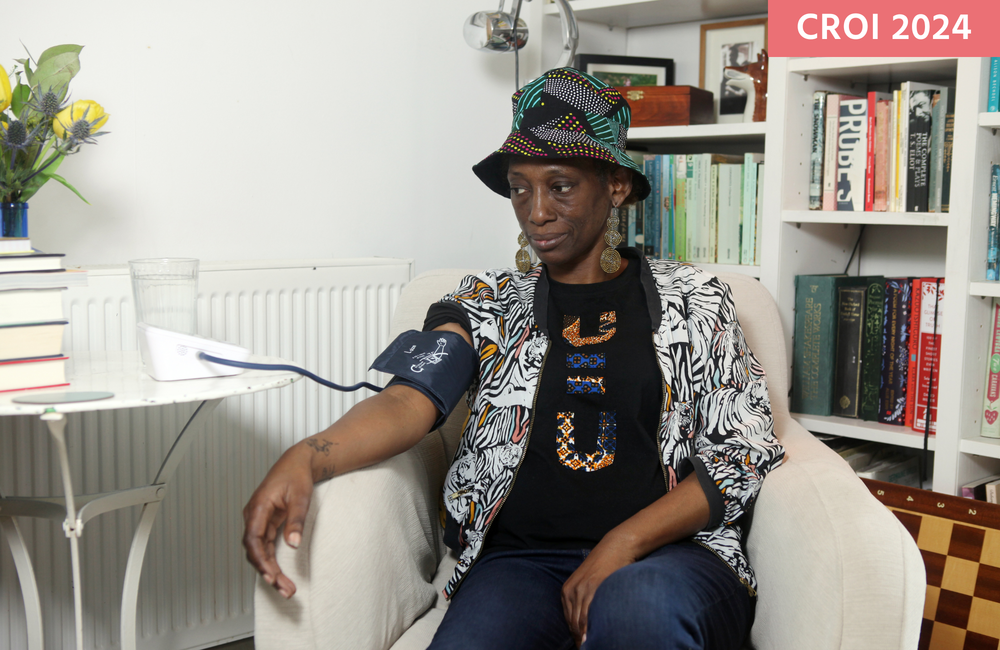
Counselling about heart disease risk and statin use for women with HIV should highlight the similar levels of risk for men and women with HIV when communicating the results of the REPRIEVE study, one of the study’s investigators told the Conference on Retroviruses and Opportunistic Infections (CROI 2024) in Denver, US, last week.
Advice also needs to make women aware of how the symptoms of heart disease differ in women and men.
Dr Markella Zanni, Director of Women’s Health Research in the Metabolism Unit at Massachusetts General Hospital, Boston, presented an overview of insights from the REPRIEVE trial into sex-related differences in cardiovascular risk in people with HIV.
The REPRIEVE study of pitavastatin for prevention of cardiovascular disease showed that statins reduced the risk of major cardiovascular events such as heart attack and stroke by a similar extent in men and women (approximately 35%). The study recruited people with HIV who had a low-to-moderate risk of cardiovascular disease based on their age, cholesterol levels and other major risk factors.
But the study uncovered an unanticipated level of cardiovascular risk in women with HIV, especially in high-income countries.
In the general population, women have a lower estimated cardiovascular risk than men. Indeed, in the REPRIEVE study, the average 10-year cardiovascular risk score on study entry was 1.9% in women and 5.4% in men, even though the median age of male and female participants was similar. Women who joined the study were less likely to smoke but more likely to have high blood pressure than men, and a higher proportion of women were Black or African American.
Yet when the incidence of major cardiovascular events was compared in four strata of baseline cardiovascular risk, from less than 2.5% to above 10% risk, women had the same rate of events as men. In the highest risk strata, there was a strong trend towards a higher incidence of major events in women. Female sex-at-birth was not protective against major cardiovascular events in the study population as a whole after controlling for other risk factors.
The cardiovascular risk score under-predicted the rate of cardiovascular events in women and in trial participants in high-income countries. In women, the rate of events exceeded the predicted number by 42%. In high-income country participants, the rate of events exceeded the predicted number by 30%. The mismatch between predicted and actual events was most pronounced in women in high-income countries, where the cardiovascular event rate was two-and-a-half times higher than would have been predicted from the scores.
Dr Zanni said that the findings of REPRIEVE should shift how women with HIV are counselled about cardiovascular risk and statin therapy, especially in high-income settings. New guidelines in the United Kingdom and the United States recommend statin treatment for people with HIV, although with differing weight. Whereas the UK guidelines recommend that all people with HIV over 40 should be offered a statin irrespective of cardiovascular risk, the US guidelines recommend that for people with HIV over 40 who have a cardiovascular risk below 5%, the discussion about whether to start a statin should take into account HIV-related factors that can raise the risk.
Discussions about heart disease risk in the general population may state that women have a lower risk of heart disease than men, but this does not appear to be the case for women with HIV.
Also, physicians should encourage discussion of potential symptoms of heart disease with women with HIV, said Dr Zanni. Symptoms of heart disease and pending heart attack may differ in women. Shortness of breath, nausea, vomiting and back or jaw pain are more common symptoms in women but are often missed, according to the American Heart Association.
Why do women with HIV have a similar risk of heart disease to men? Women have a more robust innate immune response to HIV than men, leading to greater immune activation. Inflammation and immune activation promote the development of plaques, accumulations of fats that block arteries.
The reproductive hormone oestrogen affects several of the pathways through which heart disease develops and when oestrogen production declines at the menopause, cardiovascular risk increases. A baseline analysis of REPRIEVE participants found that greater reproductive ageing was associated with greater immune activation and greater waist circumference. As weight rises, so does blood pressure, a critical risk factor for heart disease.
“We need to think about mitigating immune activation and weight gain associated with the reproductive ageing transition,” said Dr Zanni.
More research is needed to understand whether the mechanisms contributing to heart disease in people with HIV differ by sex and how statins might affect these pathways. Plaque that is causing no symptoms of heart disease may have greater impact on heart disease risk in women, Dr Zanni told the conference. Also, plaque may not be the sole factor determining heart disease risk in women. Dysfunction in the tiny blood vessels that serve the heart could also raise the risk of heart disease. Both possibilities are being investigated in REPRIEVE study participants.
Zanni M et al. Sex differences in atherosclerotic CVD risks and mechanisms: insights from REPRIEVE. Conference on Retroviruses and Opportunistic Infections, Denver, symposium 9, 2024.
View the details of this presentation on the conference website.
Zanni MK et al. Factors affecting risk of major adverse cardiovascular events among people with HIV in REPRIEVE. Conference on Retroviruses and Opportunistic Infections, Denver, abstract 781, 2024.
View the abstract on the conference website.
Grinspoon SK et al. Performance of the ACC/AHA pooled cohort equations for risk prediction in the global REPRIEVE trial. Conference on Retroviruses and Opportunistic Infections, Denver, abstract 782, 2024.

